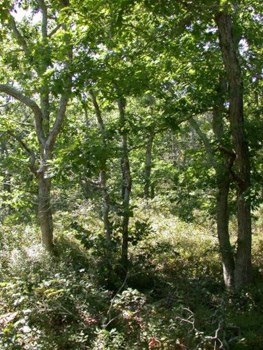
NPS photo Currently, the dominant tree species of CACO are pitch pine (Pinus rigida), black oak (Quercus velutina), and white oak (Quercus alba). Various mixtures of these comprise most of the forest habitat, which is broken up by smaller areas of black locust (Robinia pseudoacacia), red maple (Acer rubrum) and beech (Fagus grandifolia). Pitch pine is a drought-tolerant, fire-adapted species that thrives on the well-drained, acidic soils of CACO and is increasing in abundance in areas of former heathland . In many places, however, pitch pine has declined in relative abundance, giving way to the shade-tolerant and longer-lived black oak and white oak. Although oak species have sporadically been defoliated by gypsy moths over the latter half of the 1900s, the successional sequence of pitch pine to black oak to white oak now continues relatively uninterrupted across large portions of upland habitat, particularly on dry, sandy soils—a process that is encouraged by active fire suppression. In areas that are seasonally flooded, red maple and, to a much lesser extent, Atlantic white cedar (Chamacyparis thyoides) are abundant. Stands of black locust, most of which were planted by humans, exist as scattered, isolated patches throughout the middle and southern portion of CACO, whereas beech predominates within a single, unfragmented stand of mature forest at the northern tip of the peninsula.
In general, the forests and woodlands of CACO are the product of both cultural and natural influences. The independent and interactive effects of human history and the coastal environment have resulted in a unique mosaic of forest types, each with the potential to follow a different trajectory of change. Monitoring and understanding this change has become an important priority for the Seashore.
|
Last updated: February 26, 2015
